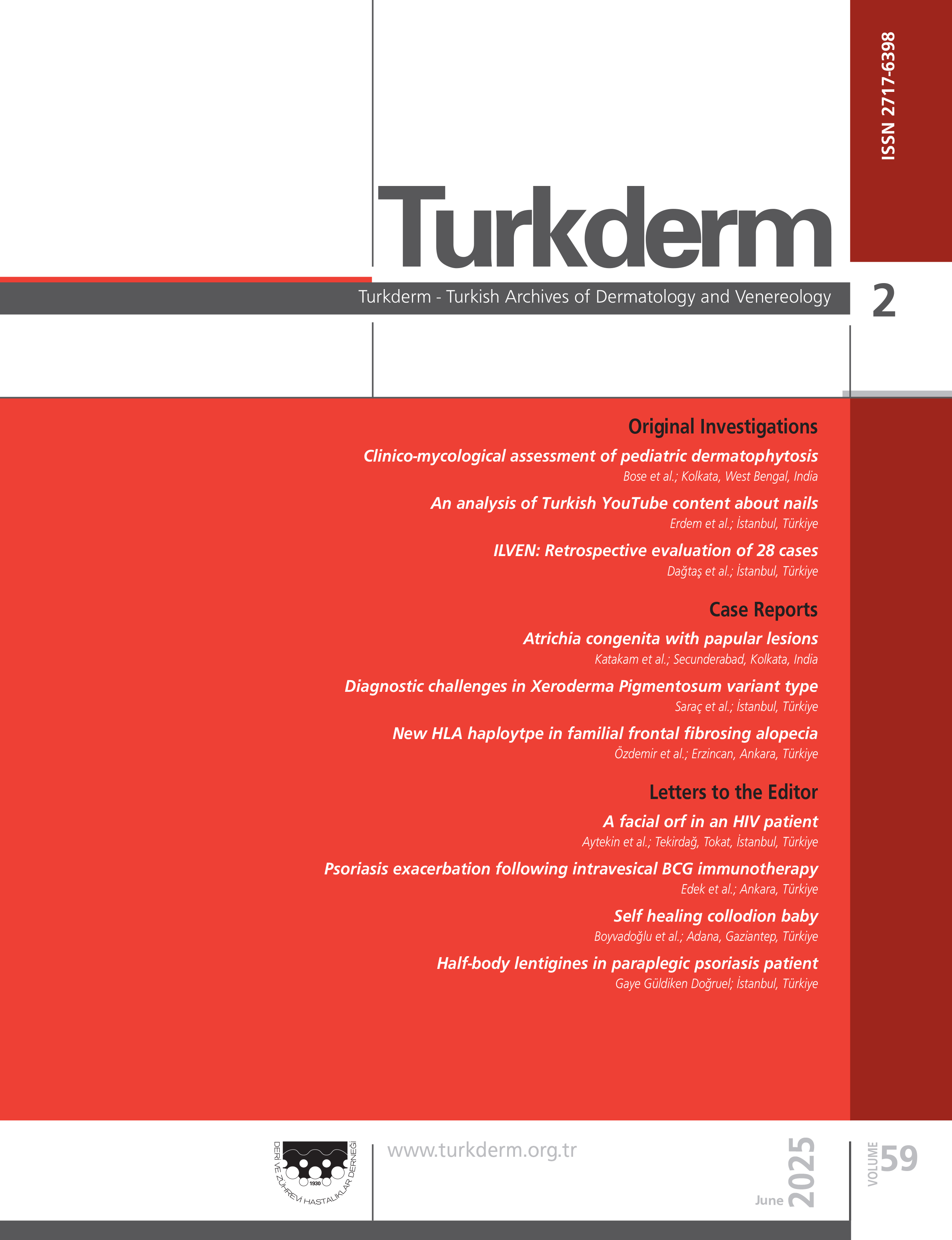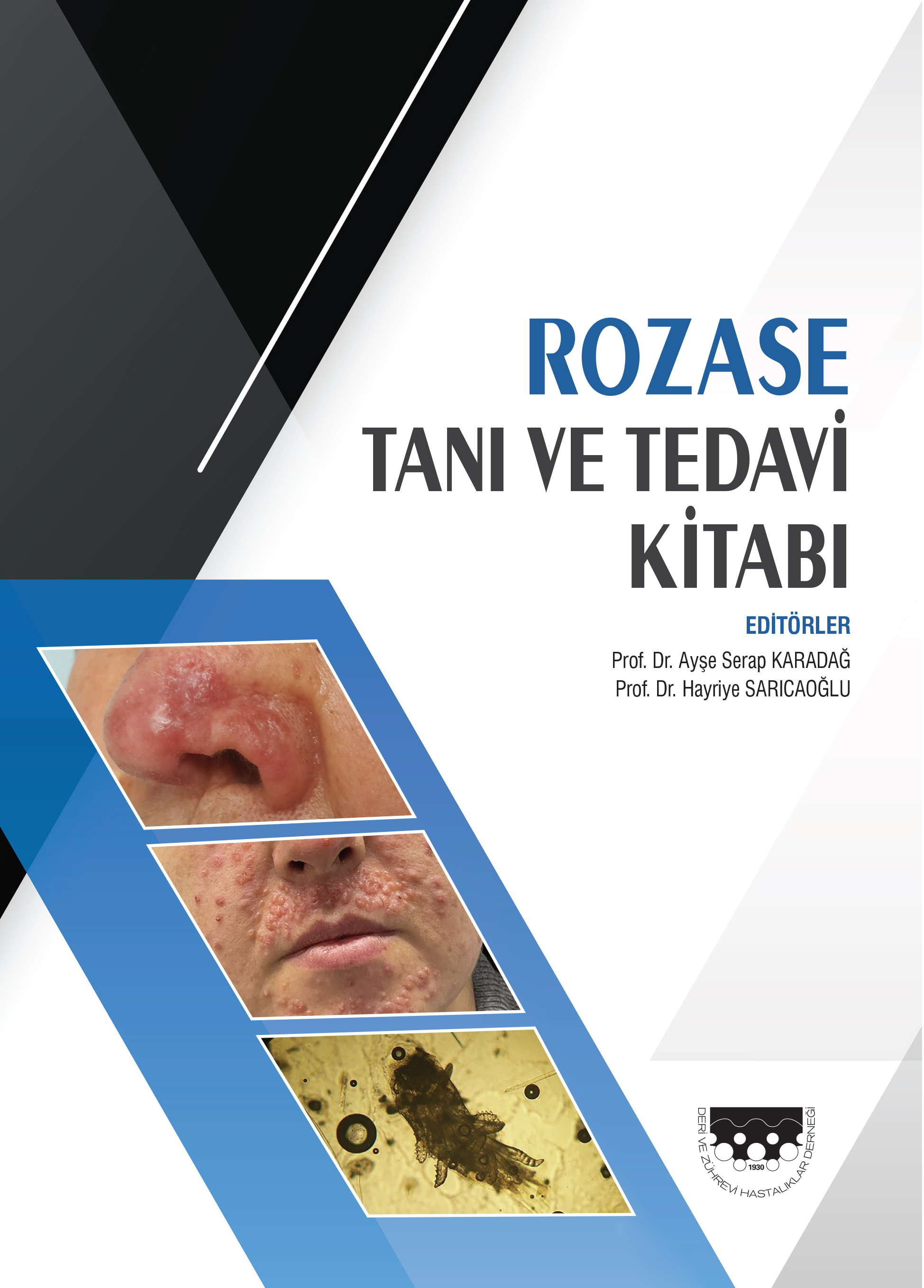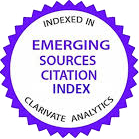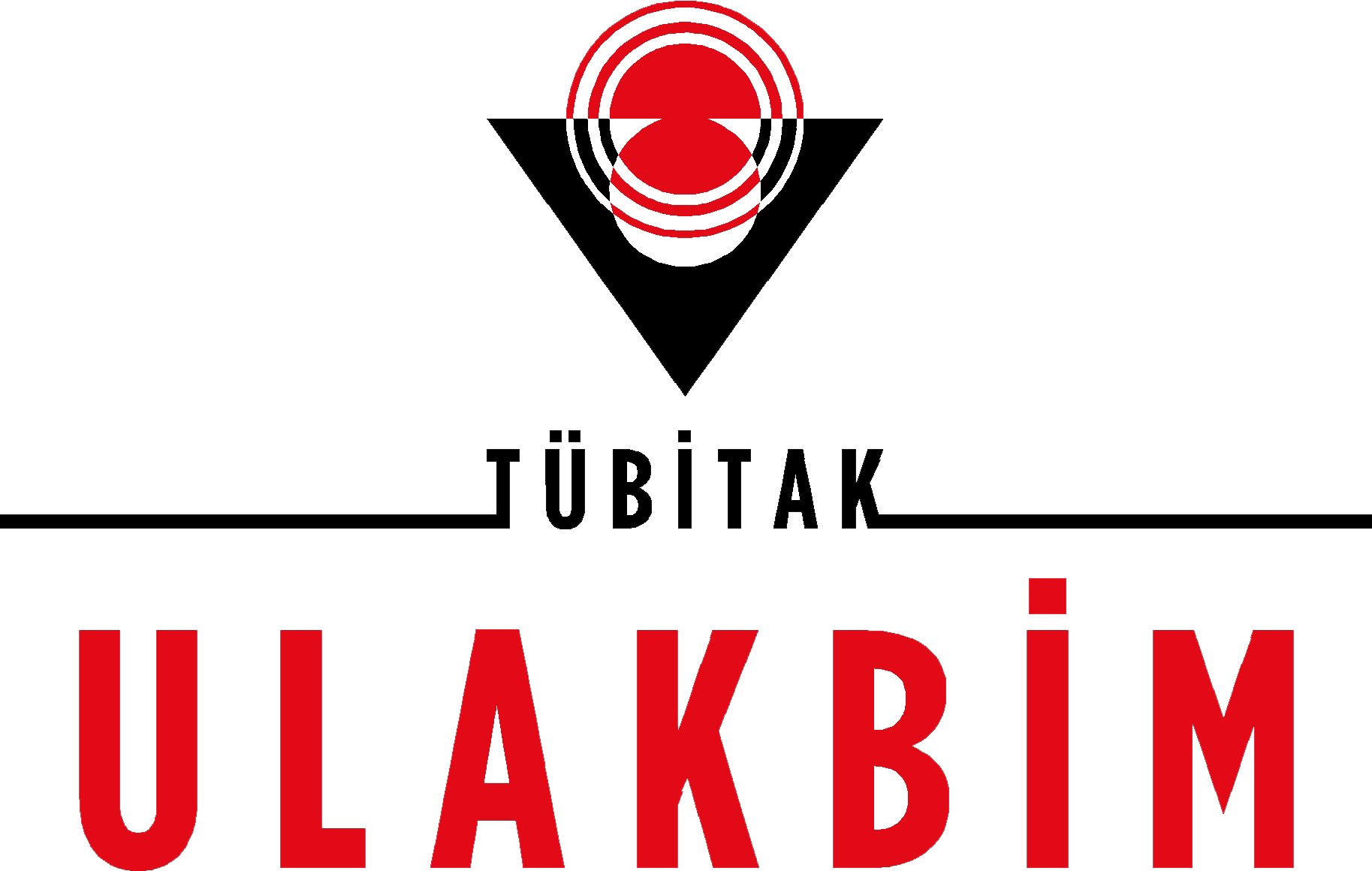Volume: 56 Issue: 3 - 2022
| 1. | Cover Pages I - IX |
| ORIGINAL INVESTIGATION | |
| 2. | Association between Localized Scleroderma Cutaneous Assessment Tool and clinicopathologic characteristics in patients with morphea Yıldız Gürsel Ürün, Elif Usturalı Keskin doi: 10.4274/turkderm.galenos.2022.07347 Pages 93 - 102 Background and Design: Morphea is also known as localized scleroderma. It is a rare autoimmune skin disease characterized by inflammation and sclerosis in the dermis and sometimes in the subcutaneous tissue. Laboratory findings, imaging, and histopathological features facilitate diagnosis and provide sufficient information about disease severity. Clinicopathologic correlations and severity factors in morphea are poorly described. Thus, this study aimed to review the clinical and histopathological features and treatment responses of patients with morphea and compare these features with disease activity and damage scores to identify new tools for assessing disease severity other than clinical findings. The applicability of the Localized Scleroderma Cutaneous Assessment Tool in clinical practice was also evaluated. Materials and Methods: This study reviewed data of 41 patients who had a histopathologically confirmed diagnosis of morphea and had been followed up regularly for at least 6 months. The modified Localized Scleroderma Skin Severity Index (mLoSSI), Localized Scleroderma Skin Damage Index (LoSDI), Physician Global Assessment-Activity (PGA-A), and Physician Global Assessment-Damage (PGA-D) were calculated at baseline and final treatment. Results: Among morphea subtypes, superficial morphea had significantly more sclerosis in the papillary dermis and plaque-type morphea had significantly more sclerosis in the reticular dermis (p<0.05). When positive antinuclear antibody (ANA) and high levels of thyroid autoantibodies were compared with mLoSSI, LoSDI, PGA-A, and PGA-D scores at baseline, no significant correlation was found. Comparison of the subgroups according to the initial mLoSSI and LoSDI scores revealed no significant histopathological differences between the groups. Conclusion: Although the mLoSSI, LoSDI, PGA-A, and PGA-D scores can be successfully used for the follow-up and treatment of patients with morphea, no correlation was found between positive ANA, high levels of thyroid autoantibodies, and histopathological features. |
| 3. | Factors contributing to activity limitations in Leprosy patients in Sitanala Leprosy Village, Indonesia Melani Marissa, Sri Linuwih Menaldi, Anandika Pawitri doi: 10.4274/turkderm.galenos.2022.99835 Pages 103 - 108 Background and Design: To investigate the association between sociodemographic variables, illness duration, leprosy types, comorbidities, and World Health Organization disability grading system for leprosy with daily activity limitations in people with leprosy who had completed multidrug therapy. Materials and Methods: A cross-sectional study was conducted in Sitanala Leprosy Village, Tangerang, Indonesia, in April 2018. Sociodemographic data and leprosy baseline characteristics were obtained from patients with leprosy who had completed multidrug therapy. The Screening of Activity Limitation and Safety Awareness scale was used to measure limitations in performing daily functional activities. Results: A total of 205 people were included in the study, of which 39 (19%) had eye disabilities, 178 (86.8%) had hand disabilities, and 187 (91.2%) had foot disabilities. A total of 135 (65.8%) people had mild-to-moderate functional limitation, and 33 (16%) had severe-to-very severe functional limitation. The proportion of unemployed individuals was higher among those with severe-extreme limitation compared to those without significant limitation (p=0.01). Individuals with eye disability had a higher risk of having severe-extreme activity limitation compared to those without eye disability (p=0.008). A dose-response association of hands and foot disabilities with activity limitation was found; the adjusted odds ratio (OR) of the association of hands and foot disabilities with mild-moderate activity limitation was 3.03 (p=0.012), and the association was greater with severe-extreme activity limitation (adjusted OR; 20.38, p=0.006). Conclusion: Severe disability is associated with functional activity limitations. The findings of the present study can guide healthcare providers in designing appropriate prevention and intervention services for patients with leprosy-related disabilities. |
| 4. | Evaluation of COVID-19 risk in patients on systemic retinoid therapy Emine Müge Acar, Kemal Özyurt, Rukiye Akyol doi: 10.4274/turkderm.galenos.2022.90132 Pages 109 - 112 Background and Design: Systemic retinoids are commonly used medications in dermatology and indicated in various skin disorders such as acne vulgaris and psoriasis. Data about the risk of Coronavirus disease-2019 (COVID-19) in patients using systemic retinoids are limited. Thus, this study aimed to investigate the risk of COVID-19 in patients undergoing systemic retinoid therapy. Materials and Methods: A total of 186 patients who have undergone systemic isotretinoin and acitretin therapy were recruited. Patients who presented to the dermatology clinic for various skin diseases, such as eczema, vitiligo, tinea, etc., who were not on systemic retinoid therapy, and who received topical medications comprised the control group. The development of COVID-19 in the retinoid therapy group and the control group was retrospectively reviewed using hospital database. Results: The mean age of the patients in the retinoid therapy group was 25.72±0.67 and that in the control group was 25.4±0.62. Moreover,165 patients received isotretinoin, and 21 patients received acitretin treatment. The isotretinoin dosage ranged from 0.5 to 0.8 mg/kg wheras the acitretin dosage ranged between 10 and 25 mg/day. Two patients (1.07%) in the retinoid therapy group and 8 (4.3%) patients in the control group were diagnosed with COVID-19. None of the patients receiving acitretin was diagnosed with COVID-19. COVID-19 diagnosis was established in the 2nd and 3rd months of isotretinoin treatment, and lung involvement was not observed. No significant difference regarding the number of COVID-19 cases and disease severity was found between the two groups (p=0.105; p=0.258, respectively). Conclusion: Isotretinoin and acitretin use was not associated with increased COVID-19 risk or disease severity. Systemic retinoids appear to be a safe treatment modality in the COVID-19 era. |
| 5. | Serum vitamin B12, ferritin, and vitamin D levels in patients with seborrheic dermatitis: A case-control study Semih Güder, Hüsna Güder doi: 10.4274/turkderm.galenos.2022.30776 Pages 113 - 117 Background and Design: No evidence suggests that any micronutrients are associated with seborrheic dermatitis (SD). The etiopathogenesis of SD is attributed to excessive proliferation of Malassezia species in the skin, deterioration in epidermal barrier functions, and inflammation. Vitamin B12 affects the immune system. Moreover, the ferritin molecule can act as a proinflammatory cytokine and has immunomodulating effects. Vitamin D has immunomodulatory effects and affects the epidermal barrier. Therefore, we thought that low serum levels of these parameters might affect immune responses against Malassezia species that caused SD. The study aimed to compare the serum vitamin B12, ferritin, and vitamin D levels of patients with SD with healthy controls. Materials and Methods: Patients aged 18-50 years who applied to the dermatology outpatient clinic and were found to have SD during dermatological examination were retrospectively reviewed. Serum vitamin B12, ferritin, and vitamin D levels of 63 patients with SD and 37 healthy controls were compared. Categorical variables were compared using chi-square analysis. Students t-test was used to compare constant variables, and Pearsons correlation test was applied for the correlation analysis. P<0.05 was considered significant. Results: No significant difference was found in the serum vitamin B12, ferritin, and vitamin D levels between the patient and control groups (p=0.227, p=0.381, p=0.611, respectively). In addition, no significant difference was found between the patient and control groups in terms of serum vitamin B12, ferritin, and vitamin D levels, which were categorized as deficient, insufficient, and adequate (p=0.31, p=0.53, and p=0.80, respectively). Conclusion: Routine measurements of these values are not necessary, but since detected subclinical vitamin B12 deficiency was detected in the patient group, this should be investigated in prospective controlled studies with a large number of patients. |
| 6. | Comorbidities in pediatric psoriasis patients: A retrospective single-center study Gülistan Maçin, Hayriye Sarıcaoğlu, Serkan Yazici, Emel Bülbül Başkan, Kenan Aydoğan doi: 10.4274/turkderm.galenos.2022.53896 Pages 118 - 131 Background and Design: This study aimed to investigate the effects of the comorbidities on disease severity and outcomes in pediatric psoriasis patients. Materials and Methods: A total of 366 patients enrolled to the study were ≤18 years old and were followed up between January 2013 and December 2017. Age, gender, family history, localization, clinical type, severity, treatments, duration of treatment/response, and comorbidities were retrieved retrospectively. Physician Global Assessment was used for psoriasis severity. All parameters were compared statistically in between groups that patients with or without comorbidities. Statistical significance was accepted p<0.05. Results: Of the 366 patients 62.6% were women, and 37.4% were men. At least one comorbidity was detected in 39.3% of the patients. The most common observed comorbidity was allergic rhinitis (8.1%), and obesity (7.1%) was the second most common. The duration of treatment was higher in patients with comorbidity than in patients without comorbidities, and the duration of the disease was statistically significant (p=0.043). Scalp, face, nail, and palmoplantar involvement was more common in patients with comorbidity than in patients without comorbidity (p>0.05). Those with comorbidity were generally higher in patients with moderate to severe psoriasis (p=0.165). In patients with epilepsy, asthma, allergic rhinitis, and valvular disorders, the clinical manifestation was mild. Biological agent use is statistically higher in comorbidity group (p=0.045). It was found that the rates of complete and partial remission rates were lower, and relapse was higher in the comorbidity group, but this was not statistically significant. Conclusion: In this study, a significant relationship was found between comorbidity and disease duration (p=0.043). Comorbidities in cases of moderate to severe psoriasis and accompanying cases. Our results are compatible with previous literature, which indicates that the key to managing pediatric psoriasis is investigation and recognition of comorbidities. |
| CASE REPORT | |
| 7. | Eccrine chromhidrosis in severe acute respiratory syndromecoronavirus- 2 virus infection treated with favipiravir Müge Göre Karaali, Gizem Issın, Soner Karaali, Şevki Özdemir doi: 10.4274/turkderm.galenos.2022.11455 Pages 132 - 134 Coronavirus disease-2019 (COVID-19) caused by the severe acute respiratory syndrome-coronavirus-2, which became a pandemic, may have cutaneous findings. Eccrine chromhidrosis is a rare disorder characterized by the excretion of colored sweat via the eccrine sweat glands. We present eccrine chromhidrosis in two COVID-19 cases treated with favipiravir. |
| 8. | Vitiligo in a patient with metastatic melanoma receiving human immunoglobulin G4 monoclonal antibodynivolumab treatment Şule Gökşin, Serkan Değirmencioğlu doi: 10.4274/turkderm.galenos.2022.47527 Pages 135 - 137 Nivolumab is an immunotherapy drug developed to increase the ability of the immune system to target and kill cancer cells and is a human immunoglobulin G4 monoclonal antibody blocking programmed cell death-1. Nivolumab is a checkpoint inhibitor that stops a signal that hinders stimulation of the tumor cell-attacking T-cells. It is a relatively new drug used in melanoma treatment. A 67-year-old male patient was operated on for acral lentiginous melanoma and admitted to our outpatient clinic with white spots on his face, head, and back of both hands while receiving nivolumab treatment. New-onset vitiligo during melanoma treatment is associated with more favorable clinical outcomes. Improved survival was demonstrated in this type of patient. Therefore, nivolumab treatment was continued because of new-onset vitiligo in our patient. This patient was living for 4 years without any clinical progression since receiving nivolumab treatment. Hence, this case is reported. |
| 9. | Trichofolliculoma on gluteal area: A unique case report Sinan Can Taşan, Canten Tataroğlu, Ekin Şavk, Fatma Nalbant doi: 10.4274/turkderm.galenos.2022.12499 Pages 138 - 140 Trichofolliculoma is a rare benign cystic nodule, consisting of a central dilated hair follicle that radiates into the surrounding dermis. Trichofolliculoma presents as a dome-shaped, solitary, 0.5-1.0 cm diameter of papule or nodule with a central pore. The clinical differential diagnosis of trichofolliculoma includes basal cell carcinoma, milia, keratoacanthoma, trichoepithelioma, and syringoma. Histopathological differential diagnosis includes trichoepithelioma, dilated pore of Winer, pilar sheath acanthoma, and basal cell carcinoma. Trichofollicumas usually occur on the face and less frequently on the neck and scalp. The gluteal area is an unprecedented site for trichofolliculoma although some unusual locations were observed. Herein, we report a very rare trichofolliculoma of the gluteal area which was not reported in English literature. |
| 10. | Cutis marmorata telangiectatica congenita on hand and forearm: Initial and follow-up observations of a rare case Cemre Büşra Türk, Dilara İlhan, Ozan Erdem, Mehmet Salih Gürel, Ayşe Esra Koku Aksu doi: 10.4274/turkderm.galenos.2022.98957 Pages 141 - 144 Cutis marmorata telangiectatica congenita (CMTC) is a rare, benign, cutaneous vascular anomaly usually located on lower limbs. It regresses spontaneously in time and sometimes may be seen with accompanying abnormalities. We present a 2-months-old girl with CMTC on hand and arm and no improvement in her 4-years follow-up period. Furthermore, we review CMTCs clinical features, evaluate the differential diagnosis approach, and emphasize the necessity of long-term follow-up accompanied by literature. |
| WHAT IS YOUR DIAGNOSIS? | |
| 11. | What is your diagnosis? Gülistan Maçin doi: 10.4274/turkderm.galenos.2022.01460 Pages 145 - 146 Acute genital ulcers are painful and distressing to women. Lipschutz Ulcer is an uncommon disease that typically occurs in sexually inactive young women. The main differential diagnosis are sexually-transmitted or non-infectious diseases which cause genital or oro-genital ulcerations. This article aims to review the diagnosis of acute genital ulcers and, through a rare case of acute genital ulcerations, to discuss diagnostic procedures. |























